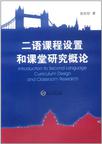二语课程设置和课堂研究概论
出版时间:2011-9 出版社:武汉大学出版社 作者:张珍珍 页数:253
内容概要
《二语课程设置和课堂研究概论》介绍了SPSS在二语研究中的应用,包括T检验、方差检验、相关度检验、线性回归和卡方检验,描述了操作步骤,展示和解释了表格。
书籍目录
Chapter One Overview of EducationⅠ. Knowledge of EducationⅡ. Aims of Education (The Aims Give Direction to Curriculum)Ⅲ. The Critical TheoryⅣ. Aims of CollegesⅤ. Aims of UniversitiesⅥ. Aims of the Learning SocietyⅦ. Curriculum OrientationChapter Two Second Language Curriculum Theory and DesignⅠ. Principles of Second Language Curricfilum DesignⅡ. Curriculum Evaluation 1Chapter Three Second Language Syllabus Theory and DesignⅠ. Category of SyllabusⅡ. Difference Between Traditional Syllabus and Process SyllabusⅢ. A Syllabus for Language Teaching Ⅳ. Four Instruments for Language Syllabus DesignⅤ. The Need for a SyllabusⅥ. Basic Organizing Principles of Syllabus DesignⅦ. Process of Syllabus DesignⅧ. Syllabus DesignⅨ. The RequirementsChapter Four Second Language Course Books Theory and DesignⅠ. Overview of the Development of Chinese College English TextbooksⅡ. Overview of the Development of College English Textbooks in the Past Years in Wuhan UniversityⅢ. Nature of Course BooksⅣ. Function of Course BooksⅤ. Principles of Course Books DesignⅥ. Evaluation of Course BooksChapter Five Second Language Instruction Theory and DesignⅠ. Instruction PlanningⅡ. Instruction ImplementationⅣ. Instruction EvaluationⅣ. Learning Outcomes and Learning ObjectivesⅤ. Instruction ResourcesⅥ. LearnersⅦ. Instruction StrategiesⅧ. Evaluation SystemⅣ. Prior Learning Assessment (PLA)Ⅹ. Teachers' RoleChapter Six Second Language Classroom Research PrinciplesⅠ. Definition of Classroom ResearchⅡ. The Purpose of Classroom ResearchⅢ. Development of Classroom ResearchⅣ. The Content of the Classroom ResearchⅤ. Observation Instrument of Classroom ResearchⅥ. The Principles and Procedure of Classroom ResearchChapter Seven Second Language Classroom Research MethodsⅠ . Action ResearchⅡ. Ethnographic ResearchⅢ. Psychometric ApproachⅣ. Interaction Analysis ApproachⅤ. Discourse Analysis ApproachChapter Eight Second Language Classroom Interaction DesignⅠ. Interaction Design of English ReadingⅡ. Interaction Design of Listening……Chapter Nine Second Language Classroom Research DimensionChapter Ten College English Teaching ReformChapter Eleven Application of SPSS in Second Language Classroom ResearchReferences
章节摘录
Generally speaking, education is composed of general education, formal educationand non-formal education. General education refers to the study of subjects and issues,such as world events or the environment which are central to life in our culture. Formal education refers to learning with credit. The learners will get diplomas ordegrees with satisfactory credits and scores described in the curriculum by the universityand pass thesis defense. e.g. Degree Policy There are three kinds of degrees: bachelor's degree, master's degree and doctor'sdegree. Students who have satisfied the requirements described in the " Regulation onAcademic Degree of the People's Republic of China" will be awarded certificates ofbachelor's degree, master's degree and doctor's degree by the university. Degree categories are composed of Philosophy, Economics, Law(including Politics, Sociology and Ethnology), Education(Physical Education), Literature(including Linguistics, Journalism, Art Studies, Library Studies), History, Science, Engineering, Agriculture and Medicine. Non-formal education means learning with no credit. The learners will not get diplomas or degrees. They will get certificates for the training program. ……
图书封面
评论、评分、阅读与下载
